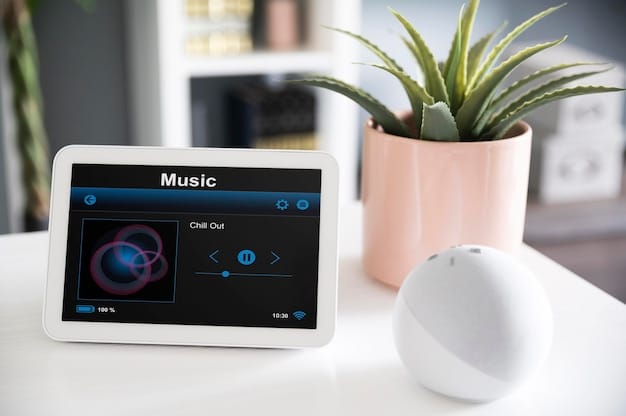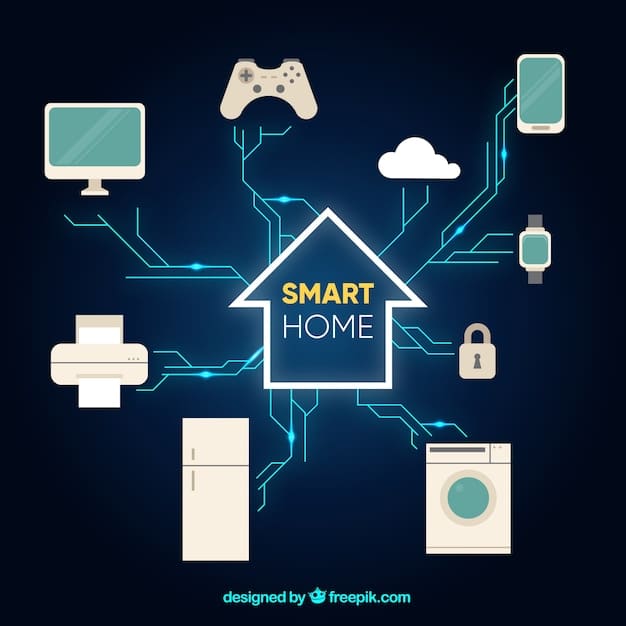Smart Home Spying? New US Data Privacy Laws Explained

The emergence of new data privacy laws in the US directly impacts smart home device usage, emphasizing consumer rights over data collected by these pervasive technologies, and signaling a significant shift in how personal information is handled and protected in the domestic sphere.
In an increasingly connected world, the convenience of smart home devices has become undeniable. From voice-activated assistants to smart thermostats and security cameras, these gadgets seamlessly integrate into our daily lives, promising enhanced comfort and efficiency. Yet, as our homes become “smarter,” a lurking concern persists: Is Your Smart Home Spying on You? New Data Privacy Laws in the US Explained herein dissect the intricate balance between technological advancement and personal privacy, especially in light of evolving legal frameworks designed to protect consumers.
The Pervasive Reach of Smart Home Technology
Smart home technology, once a futuristic concept, is now a tangible reality for millions of Americans. These integrated systems offer unparalleled convenience, automating tasks and providing real-time control over various aspects of our living environments. However, this convenience comes hand-in-hand with an inherent trade-off: the constant collection of personal data. Every interaction, every voice command, every motion detection, generates a data point that is often transmitted to cloud servers for processing and, in many cases, for analysis by tech companies.
From smart speakers listening for wake words to cameras constantly monitoring activity, the sheer volume and intimacy of data gathered by these devices raise significant privacy questions. Users implicitly trust manufacturers and service providers with sensitive information about their routines, habits, and even private conversations. This trust is foundational but can be easily eroded when data practices are opaque or when breaches occur, leading to a legitimate concern about surveillance within one’s own home.
Understanding Data Collection in Smart Homes
The types of data collected by smart home devices are diverse, ranging from benign operational metrics to deeply personal insights. Understanding these categories is crucial for grasping the full extent of the privacy challenge.
- Voice Data: Smart speakers record voice commands, and sometimes snippets of conversations, to process requests and improve voice recognition algorithms.
- Video Data: Smart cameras capture visual feeds, often equipped with facial recognition or motion detection, monitoring activities inside and outside the home.
- Location Data: Devices integrated with GPS or Wi-Fi triangulation can track users’ movements within the home or even proximity to the home.
- Usage Patterns: Smart thermostats learn temperature preferences, smart lighting tracks occupancy, and smart appliances monitor energy consumption and usage habits.
- Biometric Data: Some advanced devices may collect fingerprints or facial scans for authentication or personalized experiences.
This data, while often used to enhance device functionality and user experience, can also be aggregated, anonymized (or not), and used for targeted advertising, product development, or even shared with third parties under various terms of service. The potential for misuse, or even accidental exposure, creates a pressing need for robust data governance and legal oversight, particularly as these technologies become indispensable.
Existing Federal and State Privacy Frameworks
The United States, unlike the European Union with its comprehensive GDPR, has historically adopted a more fragmented approach to data privacy. This patchwork of federal and state laws often addresses specific sectors or types of data, rather than providing a holistic framework that universally protects consumer information, including that collected by smart home devices. This piecemeal approach can lead to gaps in protection and uneven enforcement, making it challenging for consumers to fully understand their rights and for companies to navigate compliance.
Federally, laws like the Children’s Online Privacy Protection Act (COPPA) protect children’s data, and the Health Insurance Portability and Accountability Act (HIPAA) safeguards health information. However, none directly or comprehensively regulate the broad spectrum of data gathered by smart home technologies. This regulatory vacuum has prompted states to take the lead in establishing more robust privacy safeguards, recognizing the urgency of addressing emerging digital privacy concerns that impact everyday citizens directly.
Key Federal Regulations and Their Limitations
While no single federal law specifically targets smart home data, several existing regulations offer tangential protections:
- Federal Trade Commission (FTC) Act: The FTC can pursue companies engaged in “unfair or deceptive acts or practices,” including misrepresenting data privacy policies or failing to protect consumer data adequately.
- Computer Fraud and Abuse Act (CFAA): This law primarily addresses unauthorized access to computer systems but could potentially apply in cases of illegal data breaches involving smart home devices.
- Wiretap Act (Electronic Communications Privacy Act): While often cited in discussions of digital eavesdropping, its application to smart home devices recording personal conversations without explicit consent is complex and subject to interpretation, especially given the “consent” often provided through terms of service.
These laws, however, were not designed with the nuances of pervasive IoT (Internet of Things) data collection in mind. They often lack explicit provisions for consumer consent mechanisms, data deletion rights, or specific rules around data monetization by smart home device manufacturers, illustrating the need for more targeted legislation.
Emerging State-Level Data Privacy Laws in the US
In the absence of a comprehensive federal privacy law, several US states have taken the initiative to enact their own regulations, significantly altering the landscape of data privacy for consumers and businesses alike. These state-level efforts are often seen as precursors or models for potential federal legislation, reflecting a growing societal demand for greater control over personal data. The California Consumer Privacy Act (CCPA) and its successor, the California Privacy Rights Act (CPRA), have been particularly influential, setting a high bar for consumer data rights and impacting companies far beyond California’s borders.
Other states have followed suit, passing similar, albeit sometimes varying, privacy laws. This creates a complex regulatory environment for companies operating nationwide, requiring a nuanced understanding of privacy requirements across different jurisdictions. For smart home users, these new laws represent a critical step towards empowering them with more control over the data generated by their devices, moving beyond what was previously available under general consumer protection statutes.
Impact of Landmark State Laws on Smart Home Data

The most prominent state laws grant consumers unprecedented rights regarding their personal data. These rights are particularly relevant to smart home devices, given the intimate nature of the data they collect. The adoption of these frameworks signifies a societal shift towards greater privacy advocacy and corporate accountability.
- Right to Know: Consumers can request information about the personal data a company has collected about them, including the sources of the data, the purposes for its collection, and categories of third parties with whom it is shared. For smart homes, this means owners can inquire what specific voice recordings, video snippets, or usage patterns are being stored.
- Right to Delete: Users can request the deletion of their personal data held by companies. This is crucial for smart home data, allowing users to remove sensitive information that might be stored on company servers indefinitely.
- Right to Opt-Out of Sale/Sharing: Consumers have the right to opt-out of the sale or sharing of their personal data. This directly impacts companies that might monetize smart home data through targeted advertising or profiling.
- Right to Correct: New provisions in some laws allow consumers to request corrections to inaccurate personal data.
- Right to Limit Use and Disclosure of Sensitive Personal Information: Certain laws give consumers the power to limit the use and disclosure of sensitive personal information, which often includes precise geolocation, health information, and certain biometric data—all potentially collected by smart home devices.
These rights empower consumers, giving them a legal standing to demand transparency and control. Companies, in turn, are forced to re-evaluate their data collection practices, storage protocols, and data-sharing agreements, pushing them towards more privacy-centric designs and policies to avoid hefty penalties and maintain consumer trust.
The Challenges of Enforcement and Compliance
While new data privacy laws offer a beacon of hope for consumers, their effective enforcement and corporate compliance present significant challenges. The sheer volume of data, the complexity of smart home ecosystems, and the global nature of data processing mean that ensuring accountability is no easy feat. Regulatory bodies often face an uphill battle in keeping pace with rapid technological advancements, leading to a perpetual game of catch-up. Furthermore, the fragmented legal landscape, with different rules in different states, complicates compliance efforts for companies that operate nationally or internationally, sometimes leading to a least-common-denominator approach or a focus solely on the most stringent regulations.
For consumers, exercising their newly granted rights can also be a cumbersome process. Requesting data, understanding privacy policies that are often laden with legal jargon, and verifying deletion or opting out of data sharing requires a level of digital literacy and persistence that many may not possess. This gap between legal provision and practical application remains a critical area for improvement in the evolving data privacy narrative, underscoring the need for simpler, more accessible mechanisms for privacy management.
Navigating the Nuances of Data Flow
Smart home data flows through a complex network of devices, apps, cloud services, and third-party integrations. This intricacy makes it difficult to pinpoint exactly where data resides, how it is processed, and who has access to it. Each layer in this ecosystem introduces potential privacy vulnerabilities and challenges for compliance. Developers must consider data privacy from the design phase, adopting “privacy by design” principles, but the implementation can vary significantly. Moreover, the definition of “personal data” itself can be a point of contention, especially when data is anonymized or aggregated, raising questions about whether such data still falls under privacy law protections. The future of data privacy for smart homes will heavily depend on fostering clearer data lineage and transparent data handling practices across the entire value chain.
Complying with diverse state laws also requires significant investment in legal expertise, technological infrastructure, and operational changes. Companies must implement robust data mapping, consent management platforms, and streamlined processes for handling consumer requests, placing a substantial burden on resources. Smaller businesses, in particular, may struggle to meet these new demands, potentially limiting innovation within the smart home sector. The push for a unified federal privacy law is partly driven by the desire to reduce this compliance complexity and create a level playing field for all entities handling consumer data.
Protecting Your Privacy in a Smart Home
Despite the complexities of legal frameworks and corporate compliance, consumers are not powerless in protecting their privacy within their smart homes. A proactive approach, combining awareness, judicious device selection, and diligent privacy management, can significantly mitigate the risks associated with pervasive data collection. Understanding the capabilities of each device, the terms of service accepted, and the privacy settings available are fundamental steps towards regaining control. This personal responsibility complements the broader legislative efforts, creating a more secure digital footprint within the domestic environment.
Empowering oneself with knowledge about how smart devices function, what data they collect, and how that data is used is the first line of defense. Engaging with privacy policies, though often lengthy, can reveal critical information about data retention, sharing practices, and consent mechanisms. For anyone concerned if their smart home is spying on them, adopting a vigilant stance is perhaps the most immediate and effective measure.
Best Practices for Smart Home Users

Taking concrete steps to manage your smart home’s data footprint is essential. These practices move beyond mere awareness, translating knowledge into actionable privacy safeguards. Regularly reviewing and adjusting settings across all devices can make a substantial difference in reducing unwanted data collection and exposure.
- Review Privacy Policies: Before purchasing and setting up any smart device, read its privacy policy carefully. Understand what data is collected, how it’s used, and whether it’s shared with third parties.
- Adjust Device Settings: Customize privacy settings on each device and its accompanying app. Disable features you don’t use, such as voice history recording or advanced analytics.
- Strong, Unique Passwords and Two-Factor Authentication: Use complex, unique passwords for all smart home accounts and enable two-factor authentication (2FA) wherever available to prevent unauthorized access.
- Regularly Update Firmware: Keep your devices’ firmware and apps updated. Manufacturers often release updates that include security patches and privacy enhancements.
- Segment Your Network: Consider creating a separate Wi-Fi network for your smart home devices (a guest network or a dedicated IoT network) to isolate them from your main personal computers and sensitive data.
- Be Mindful of Voice Commands: Understand that voice assistants may record conversations beyond direct commands. Be selective about placing such devices in highly private areas.
- Exercise Your Data Rights: Utilize the rights granted by new state laws (e.g., right to know, delete, opt-out) to request information or removal of your data from companies.
- Consider Device Placement: Be strategic about where you place smart cameras and microphones. Limit their exposure to sensitive areas of your home or private conversations.
By implementing these practices, users can create a more secure and private smart home environment, minimizing the potential for unwarranted data collection and maintaining a greater degree of control over their personal information. This proactive approach empowers individuals to enjoy the benefits of smart technology without compromising their fundamental right to privacy.
The Future of Smart Home Privacy Legislation
The trajectory of data privacy legislation in the United States suggests a continued evolution towards more comprehensive and standardized protections for consumers. While a federal privacy law remains elusive, the momentum generated by state-level initiatives is undeniable, creating a strong impetus for national action. The increasing public awareness and advocacy regarding digital privacy concerns are likely to further fuel this legislative push. As smart home technology becomes even more deeply embedded in daily life, the urgency for robust and clear legal guidelines will only intensify, impacting both consumers and manufacturers.
Future legislation will likely focus on several key areas, including enhancing explicit consent mechanisms, strengthening data minimization principles, and expanding consumer rights to data portability and algorithmic transparency. The goal is to move beyond mere disclosure to empower consumers with meaningful control over their digital lives. The ongoing dialogue between policymakers, industry leaders, and privacy advocates will be crucial in shaping a balanced regulatory environment that fosters innovation while rigorously protecting individual privacy in the smart home ecosystem and beyond.
Potential Directions for Federal and State Initiatives
Looking ahead, several legislative approaches could define the future of smart home privacy:
- Federal Comprehensive Privacy Law: There is a growing consensus among some lawmakers and industry groups for a single federal privacy law that would preempt disparate state laws, providing uniformity and clarity for businesses and consumers. Such a law would likely incorporate elements seen in CCPA/CPRA, potentially extending data rights across all sectors.
- Sector-Specific Regulations: While a comprehensive law is debated, specific regulations targeting IoT devices and smart homes might emerge at the federal level, akin to HIPAA for healthcare data. This could address unique privacy challenges posed by interconnected consumer devices directly.
- Enhanced Enforcement Powers: Regulatory bodies like the FTC may receive stronger enforcement powers and increased funding to investigate and penalize companies that violate privacy rules, ensuring greater accountability.
- International Alignment: As data crosses borders, future US legislation might seek greater alignment with international standards like GDPR, facilitating global data flows while upholding strong privacy principles.
- Focus on Data Security: Beyond privacy rights, there will likely be increased emphasis on mandating robust security measures for smart home devices to prevent breaches and unauthorized access to sensitive data.
Ultimately, the aim is to create a predictable and protective environment where consumers can confidently embrace smart home technology without the constant worry of their homes secretly collecting and misusing their most personal information. The legal landscape is shifting towards a future where privacy by default and consumer control are not just aspirations but legal requirements.
| Key Aspect | Brief Description |
|---|---|
| 🏠 Data Collection Focus | Smart devices gather voice, video, location, and usage data, raising significant privacy concerns. |
| ⚖️ US Legal Landscape | Fragmented federal laws, but pioneering state laws (e.g., CCPA/CPRA) are leading privacy protections. |
| 🔒 Consumer Rights | New laws grant rights to know, delete, opt-out, and correct personal data, empowering users. |
| 🛡️ User Protection Measures | Reviewing policies, adjusting settings, and using strong security are key user best practices. |
Frequently Asked Questions About Smart Home Privacy
Most smart home devices, particularly voice assistants, are designed to only record after a “wake word” is detected. However, instances of accidental or continuous recording have been reported. It’s crucial to review device settings and privacy policies to understand their specific recording behaviors and how to limit them.
Under older frameworks, data could sometimes be sold under broad terms of service. However, new state data privacy laws like CCPA and CPRA often grant consumers the “right to opt-out” of the sale or sharing of their personal data, making it more difficult for companies to do so without explicit consent or prior notification.
“Privacy by design” is an approach where data protection and privacy are built into the design and operation of information systems from the outset, rather than being added later. For smart homes, this means manufacturers would integrate robust privacy controls and data minimization techniques into devices and services from their conceptual stages.
State laws like CCPA/CPRA grant consumers rights such as the right to know what data is collected, to request its deletion, and to opt out of its sale. These rights empower smart home users to have more control over the personal information gathered by their devices, requiring companies to be more transparent and responsive to data requests.
Currently, the US does not have one overarching federal law specifically focused on smart home data privacy. Instead, there’s a patchwork of federal laws that offer indirect protections. The push for a comprehensive federal privacy law is ongoing, aiming to create uniform standards across all states and industries, including the smart home sector.
Conclusion
The journey to truly secure and private smart homes is an ongoing one, defined by a dynamic interplay between technological innovation, legal frameworks, and consumer awareness. While the convenience offered by these intelligent devices is undeniable, the underlying privacy implications demand careful consideration and proactive measures. The emergent data privacy laws at the state level in the US represent a significant stride towards empowering consumers with greater control over their personal information, fostering transparency, and holding technology companies accountable for their data handling practices. As these legal landscapes continue to evolve, the collective responsibility of device manufacturers to prioritize privacy by design, legislative bodies to enact comprehensive protections, and consumers to exercise their digital rights will shape the future of privacy in our increasingly connected domestic spaces.





